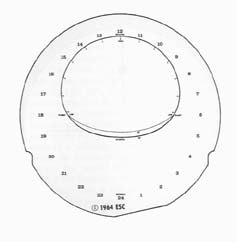Reading the Fixed Disc (B)
The Horizon and Hour Disc
The zenith or south meridian position for any heavenly body (sun, moon or star) is the imaginary fixed radial line from the center of this disc to the position It south" at the top of the clock. The time at which any of these bodies, on its rotating disc, crosses this line is the time at meridian or zenith.
The time indicated by the gold sun line traversing the gold 24-hour scale on this disc registers true solar time. Remember, when relating solar time to standard time, as shown on lower left clock dial, the conversion factor for your particular longitude must always be used.
The light blue arrow on Star and Calendar Disc (E) as it traverses the gold hour numerals on this disc, registers sidereal or star time. See page for an explanation of sidereal time.
The light blue ellipse (horizon line) on this disc is important because it encloses the approximate area within which the sun and moon and the stars are visible from the earth. The lower continuous line of the ellipse is marked North 400, and above it the dotted line is marked 300. These represent degrees of latitude. North 400 passes through Philadelphia, Pa. and North 300 through New Orleans, La. If you are located near the latitudes mentioned above, any heavenly body within this light blue ellipse will be visible and it will be at the approximate position shown in relation to the zenith or south meridian position.
Whenever one of the graduated scales of the Tide Disc (A) reaches the zenith (marked ''HIGH'' on the blue horizon ellipse) it is high tide at the location for which you have chosen to set the Tide Disc. Blue numerals on either side of "HIGH" indicate, on the right, the hours before high tide; and on the left, the hours after high tide.

More pictures of Spilhaus Space Clock and how to repair it.
